We actually love Monstera plants for their beauty and relative ease of care (for the most part), but they, like most houseplants, are susceptible to household pests such as scale, mealybugs, spider mites, and thrips. We’ll tell you everything you need to know about How to get rid of thrips on Monstera plants and how to get rid of them in DIG Nursery’s article!
What are Thrips?
Thrips are small insects approximately the size of a sewing needle that eat a variety of plants all around the world. Thrips, also known as Thysanoptera or Thunderflies, are sucking insects that can harm plants. When they transmit viruses to plants, though, they can cause even more harm.
Thrips Life Cycle: Thrips life cycles vary depending on the species, region, host plant, and other variables. Thrips adults hibernate in plant waste, bark, and other materials. Early in the spring, they become active and lay eggs in plant tissue. The eggs hatch in 3–5 days, and the nymphs eat for 1–3 weeks before resting for 1–2 weeks before molting. Outside, thrips can have up to 15 generations every year. Thrips have a one-month lifespan as adults.
(Source: https://www.almanac.com/pest/thrips)

Types of Thrips on Monstera
There are two main types of thrips that feed on Monstera plants – the Western flower thrips (WFT) and the Egyptian flower thrips (EFT). Both of these pests are small, winged insects that are capable of causing extensive damage to leaves and flowers.
The Western flower thrips are the most common type of thrips found on Monstera plants. These pests are pale yellow or brown in color and measure just 1-2 mm in length. Western flower thrips feed by puncturing plant cells and sucking out the contents, which can cause leaves to become discolored and distorted.
The Egyptian flower thrips is another type of thrips that feeds on Monstera plants. These pests are slightly larger than Western flower thrips, measuring 2-3 mm in length. Egyptian flower thrips are dark brown or black in color and have a distinctive curved shape. Like Western flower thrips, they feed by puncturing plant cells and sucking out the contents, which can cause leaves to become discolored and distorted.
Both Western flower thrips and Egyptian flower thrips can cause serious damage to Monstera plants if left unchecked. If you suspect that your plant is infested with either of these pests, it is crucial to take action immediately to prevent further damage.
What Does Thrip Damage Look Like on Monsteras?
Here are the significant signs of a thrip infestation on your Monstera plant to look out for.
Yellow or brown discoloration on leaves
You’re probably aware that yellowing or browning leaves can be caused by a variety of factors. However, if you notice this discoloration occurring around a specific area of your plant, clustering in the middle of the leaf rather than concentrating on the edges, and your Monstera’s light and water conditions appear normal, insects may be a problem.
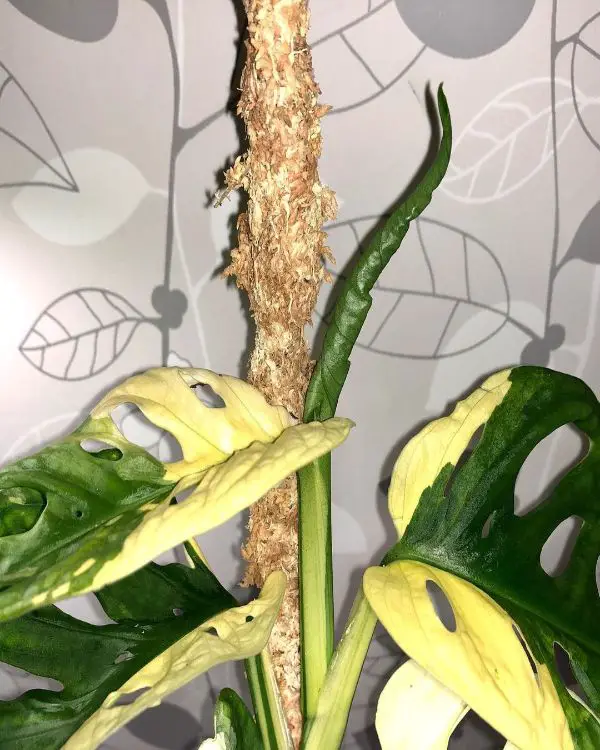
Leaves with Black Spots
When thrips burrow into your plant’s leaves to lay eggs, tiny dark brown or black spots may appear! If you see these dots, look for actual insects or other indications that you may have an infestation on your hands.
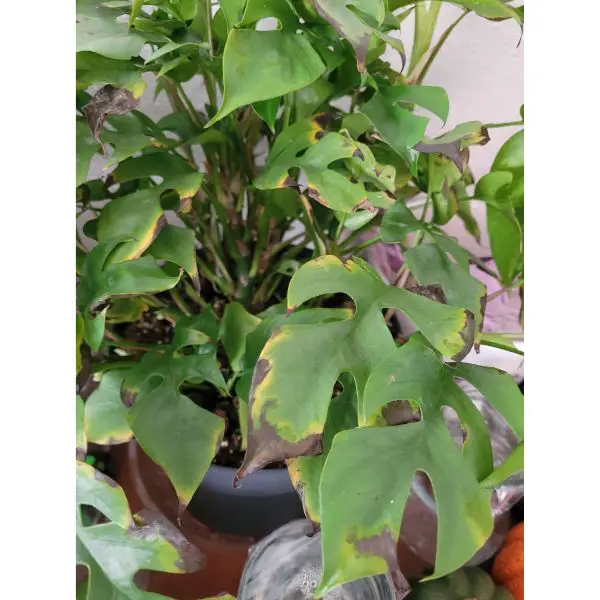
Leaves that are wilting, drooping, or curling
When the nymphs suck the sap from the leaves, the turgor pressure, or pressure from the inside of the leaf and stem tissues that helps your plant maintain its rigidity, decreases. If you notice your leaves are flimsy, wilty, droopy, or curling (especially if there are spots or discoloration), you may have a thrip problem!
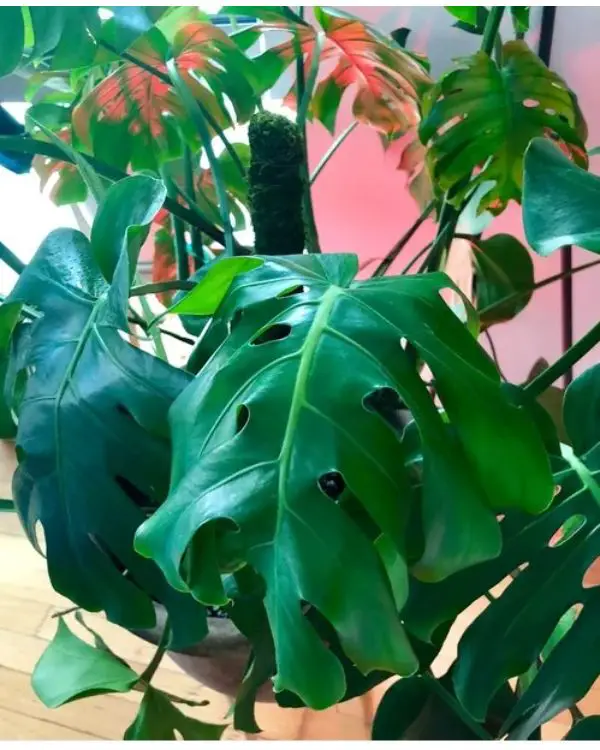
Related Post: How to detect bugs on Monstera? The most common insects
What are the Signs of Thrips on Monstera?
Adult female thrips puncture holes in the Monstera leaves and plant tissue. The eggs are then laid on the leaves. The nymphs hatch and begin feeding on the sap right away. When deprived of sap, the Monstera Deliciosa plant loses its mechanism for distributing nutrients and water throughout the plant.
The following are some symptoms of thrip infestation that you should be aware of:
- Examine for signs of lifelessness. Thrips are likely to deprive your plant of nutrition if it is becoming duller and weaker by the day.
- Examine the leaves for yellow and brown discoloration.
- Thrip-induced damage is also indicated by black spotting on the underside of the leaves.
- Look for drooping, curling, or wilting leaves.
- A magnifying glass can also be used to see thrips crawling on the underside or top of the leaves.
If you notice any of these symptoms on your Monstera plant, seek treatment and preventative measures.
How to get rid of Thrips on Monstera
Thrips can be difficult to eradicate because even after the actual insects have been removed from your plant, there may still be eggs waiting to hatch. You’ll have a whole new generation on your hands once that happens!
The best approach is multi-pronged, involving the removal of mature insects as well as the prevention of egg hatching. It may take several rounds of treatment to completely eliminate thrips, but if you catch the infestation early enough, you should be able to remove them and save your plant!
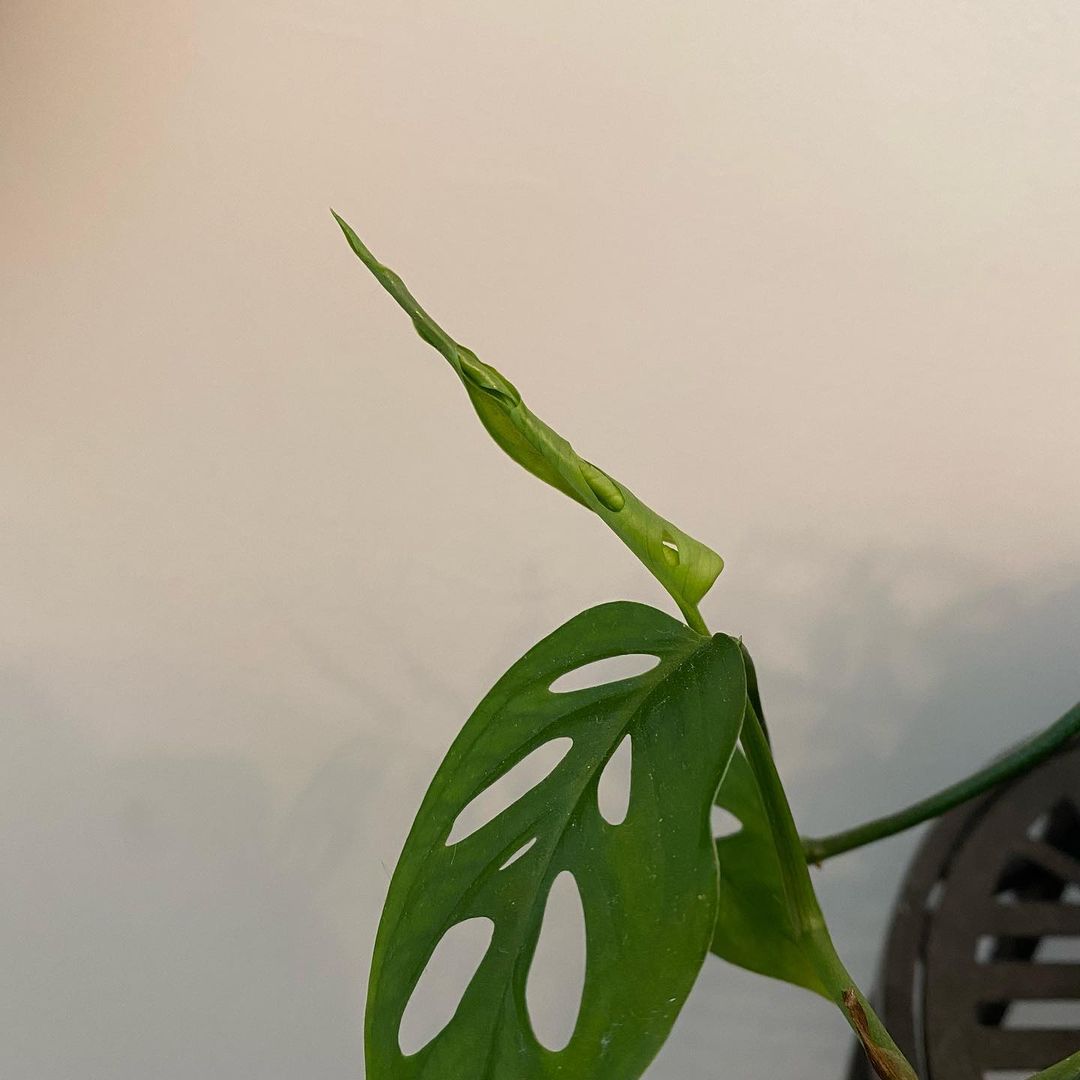
Getting Rid of Thrips with Insecticide
An insecticide is frequently required to completely eliminate thrips. You can buy it online or in gardening stores, or you can make it yourself! If you’re using a store-bought insecticide, follow the dilution instructions on the bottle, erring on the side of over-dilution just to be safe.
It’s also a good idea to test any insecticide on a small leaf or section of your Monstera to ensure there aren’t any negative side effects before spraying the entire plant! Wait a full day before using the insecticide on the entire planet, and then double-check the spot you tested. When spraying, make sure to get the tops and bottoms of the leaves as well as the stems, but don’t soak the plant. Repeat this process every 4-7 days until the thrips are gone.
How Do You Naturally Get Rid of Thrips?
There are several natural ways to treat thrips, ranging from homemade insecticides to introducing natural predators.
Insecticide Made at Home
There are numerous homemade insecticide recipes available, but our personal favorite is a simple soap-and-water solution.
To make this simple DIY insecticide, simply combine 1.5 teaspoons of gentle liquid soap with a quart of water and use it right away. Again, it’s a good idea to test it on a small section of your Monstera to ensure that it doesn’t scorch or cause any other undesirable reactions.
Because insecticide is only effective when wet, apply the spray in the morning or evening. If you use it during the hottest part of the day, it may dry out before it can really get to work on the leaves of your plant.
Rep this process every 4-7 days until you no longer see thrips and your plant’s condition has stabilized.
Neem Oil
Neem oil is a common treatment for a plant-insect infestation! You can also add a little liquid soap if you follow the dilution instructions on the bottle. Then, spray the plant with the mixture and allow it to dry. This is also a great preventative measure to keep insects at bay in the first place.
Again, it’s a good idea to test your mixture on a small portion of the plant before spraying the entire thing. Neem oil has a strange odor that goes away when it dries, so do this outside (only if your Monstera is protected from the elements) or in the garage if possible. Consider our Leaf Armor spray, which is a natural way to keep pests away from your plants.
Because neem oil only works to eliminate pests when wet (much like insecticide), it’s best to apply the spray earlier in the morning or later in the evening rather than during the hottest part of the day. This helps to keep the spray from drying out too quickly.
Blue, yellow, or white Sticky Trap
Thrips are attracted to the colors blue, yellow, and white, so take advantage of this and set traps!
These traps can be purchased in garden stores or online, but you can easily make your own by spreading honey (or another sticky substance that will stay sticky) on a sheet of blue, yellow, or white paper and placing it near your plant. Sticky notes can also come in handy in a pinch!
Lint Remover
You don’t always have the patience to wait for thrips to fall into your sticky traps. So, using a lint roller, you can essentially bring the sticky trap to them!
Simply hold a Monstera leaf flat in your palm and gently run the lint roller over it to remove thrips. Make sure to get both sides of all leaves, and maybe even give the stems a once-over.
Ladybugs should be introduced.
Ladybugs will gladly consume your thrips. If you buy ladybugs online and release them in the soil of your Monstera, they’ll quickly find a food source – the thrips – and get to work. This is especially enjoyable if you have children!
Ladybugs will most likely venture outside your Monstera to your other houseplants and even other areas of the house, which is a good thing. Ladybugs are completely harmless, so if you don’t mind having some adorable insect companions around, this could be a great option.
Pruning to Remove Damaged Leaves
When a thrips infestation has progressed, the best course of action is sometimes to simply prune off the affected leaves. This will kill any eggs that are still waiting to hatch, as well as any mature thrips that may be clinging to the leaves. Removing damaged leaves also causes your Monstera to redirect energy toward healing the remaining leaves and producing new growth.
Sterilize a pair of scissors or shears with alcohol or soap and hot water to accomplish this. You should also wear gloves because the sap from your Monstera can irritate your skin.
To begin, use the lint roller trick to remove as many thrips as possible from the leaves. Then, using a sharp knife, carefully cut the stems of the leaves you want to remove. Take care not to jar the leaves too much, as this could result in a swarm of insects landing on lower leaves or the soil. If your goal with pruning is more for aesthetics and healing than treating the infestation, you can simply cut off the damaged areas of the leaves.
If your infestation is severe and you’re going to lose a lot of leaves, consider propagating the healthy leaves and starting over with a healthy young plant.
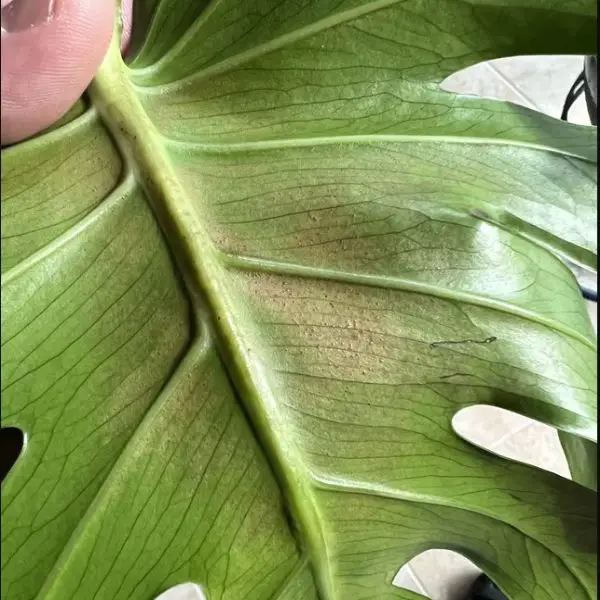
Read More: Why Is Monstera Leaf Light Green? Grow normally or an issue
Can Monstera Recover from Thrips?
The amount of damage produced by a thrip assault determines how quickly you can recover.
1) Recover when the damage is little
Early detection is really important. If you catch a thrip infestation early on, when the thrips haven’t done any damage to the plant, your Monstera will recover quickly.
After the thrips have been removed, provide your Monstera with the proper temperature, humidity, sunlight, water, and fertilizer, and it will rapidly resume its healthy growth.
2) Recuperation When Partial Damage Occurs
If a portion of your plant is damaged but the rest is unaffected, save the healthy portion, wash it to remove any thrips, then create a new full plant from the cuttings.
3) Extensive Damage Recovery
Unfortunately, if your plant has been severely harmed by thrips, it will seem significantly discolored and unable to survive.
To prevent the infestation from spreading to nearby healthy plants, it is best to remove the plant.
Monstera is a lovely plant with beautiful holed leaves and an attractive appearance. Although it is hardy, it can succumb to thrips if it is weak. Thrips are winged insects that attack a variety of houseplants, including Monstera. Don’t be concerned; pests can be removed from your monstera using adhesives and insecticides.


